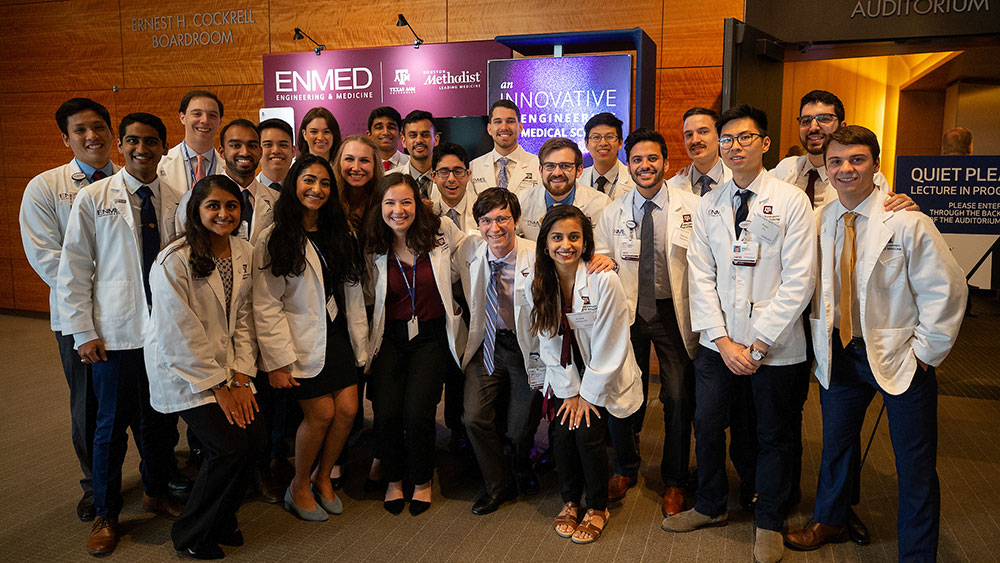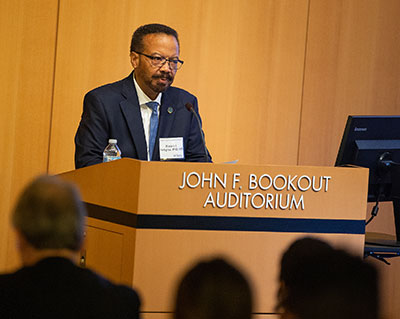
To celebrate the launch of Texas A&M University’s EnMed program that will train students jointly in medicine and engineering, a symposium was held at the Houston Methodist Hospital on Oct. 28. The attendees included current EnMed students and faculty, donors, and many distinguished guests from inside and outside academia.
EnMed is a Texas A&M initiative that combines the College of Medicine’s M.D. program and the College of Engineering’s graduate degree program. Twenty-five students are enrolled in the inaugural class that will earn both an M.D. and an M.S. in engineering. The program integrates the medical school curriculum with engineering and entrepreneurship, and will prepare students to have the skills needed to be both a successful physician and an engineer who can solve the medical field’s complex problems through technology development for patients, physicians and health care professionals.
In his opening remarks, executive dean Roderic Pettigrew, Ph.D., M.D., said: “EnMed was established to train a new kind of physician with a new kind of medical mind, one that seeks compassionate healing, but also understands engineering, the scientific laws of living things and how these are integrated in nature.

“The understanding of how engineering and biology and all scientific disciplines are seamlessly interwoven in life is core to EnMed; it is the fundamental concept on which it is based. From this greater understanding of how human life really works — at the molecular, cell and organ system levels — will come the practical solutions to unmet medical and health care needs. EnMed seeks to develop a caring doctor who is also a problem solver, at all biological levels. A physician who is an inventor — a physicianeer,” he said.
Common to all students admitted to the EnMed program is that they have a strong background in engineering and have demonstrated a clear passion for innovation. “EnMed seemed like the perfect fit for me to achieve my career goals,” said Frederick Wang, an EnMed student and a recent graduate in biomedical engineering from The University of Texas at Dallas. During his undergraduate years, Wang did extensive biomedical research on metal failure in dental implants and presented his findings at the International Association of Dental Research.
The EnMed symposium featured a talk by Harvard Medical School physician-scientist, Don Ingber, M.D., Ph.D., who is also the founding director of the Wyss Institute for Biologically Inspired Engineering. Ingber leads his institution’s efforts in developing breakthrough technologies and commercializing them for medical use. He explained to EnMed students that big discoveries happen at the intersection of diverse fields that generally include engineering, biology, medicine and industry. Hence, the ability for EnMed students to train at Texas A&M and at Houston Methodist Hospital is a huge advantage.
“I think that that you (students) are in a place where the intensity of engineering and medical research is more than anywhere and you must take advantage of it,” Ingber said.
Additional advice was given by Paul Yock, M.D., who founded the Stanford Biodesign program as professor of bioengineering and is the Martha Meier Weiland Professor in the School of Medicine at Stanford University. He said EnMed students should take a need-based approach to problem solving in the health care industry, noting that “a well characterized need is the DNA of invention.”

Other esteemed symposium speakers included Peter Agre, M.D., Nobel Prize winner in chemistry, Bloomberg Distinguished Professor of Public Health and director of the Malaria Research Institute at Johns Hopkins University; and Renaldo Nehemiah, legendary Olympian, 13-time world record holder and Congressional Gold Medal recipient.
Agre spoke of the importance of students using their talents for the benefit of others, and how ideas that spark discovery can come from surprising places at surprising times. He credits the idea that led to his Nobel Prize work to a family trip in the Everglades. Nehemiah talked about the importance of being fully committed to your goals. “You must be all in,” he said in a discussion on breaking barriers. The list of invited speakers included video greetings from Dan Mote, Ph.D., president emeritus of the National Academy of Engineering, and Victor Dzau, M.D., president of the National Academy of Medicine.
In encouragement of the aspirations of EnMed students as “pioneers,” Pettigrew, also CEO of Engineering Health and holder of the Robert A. Welch Chair in Medial Science, said that the team of faculty at Texas A&M and Houston Methodist are also pioneers, and that they are dedicated to working with EnMed students in this new educational paradigm to realize their full potential as physician-engineers and help transform health care.
After reciting then referencing the poem “Hold Fast to Dreams” by Langston Hughes, Pettigrew said, “EnMed, hold fast to dreams and we will improve health and well-being across the globe for all of mankind.”